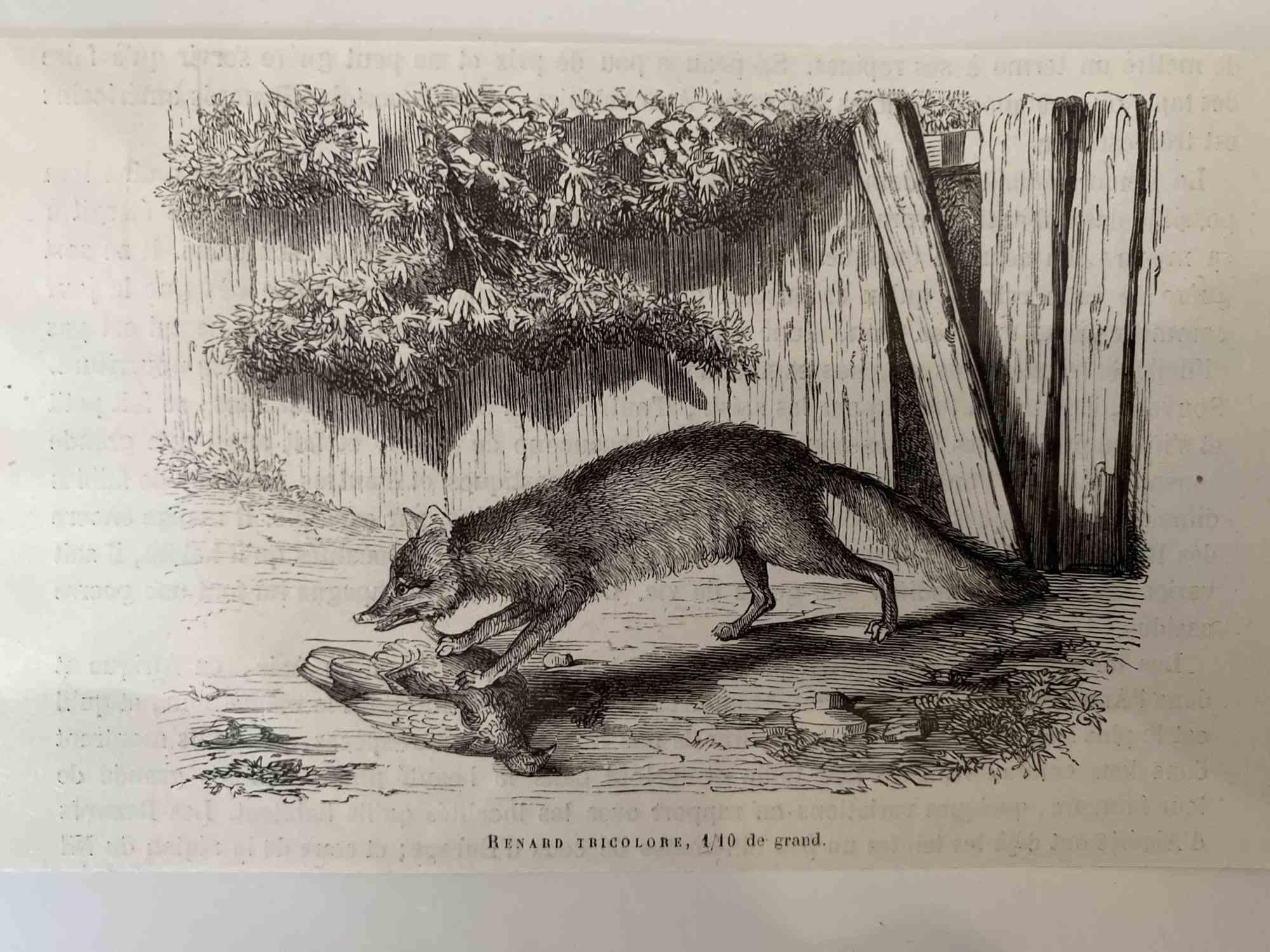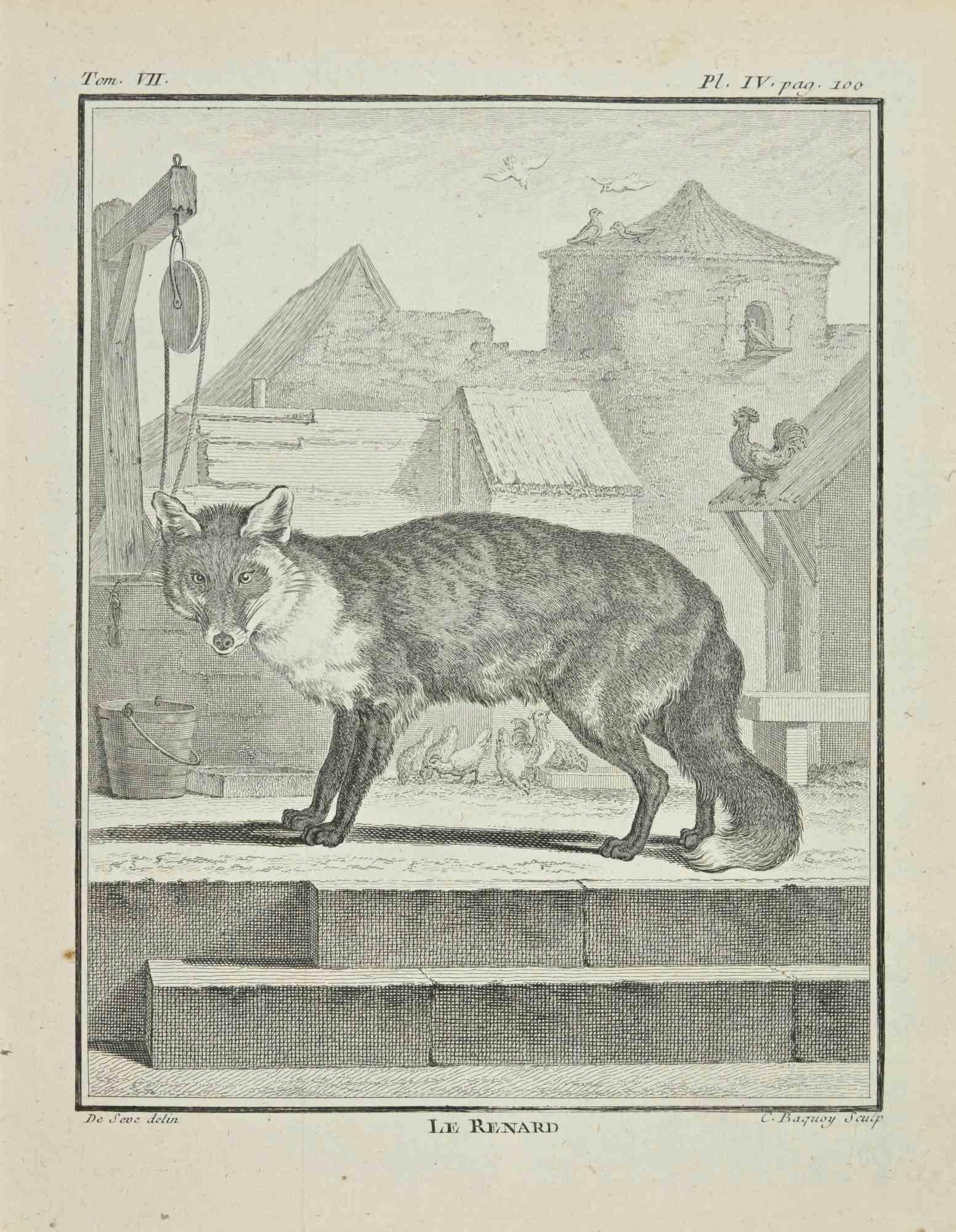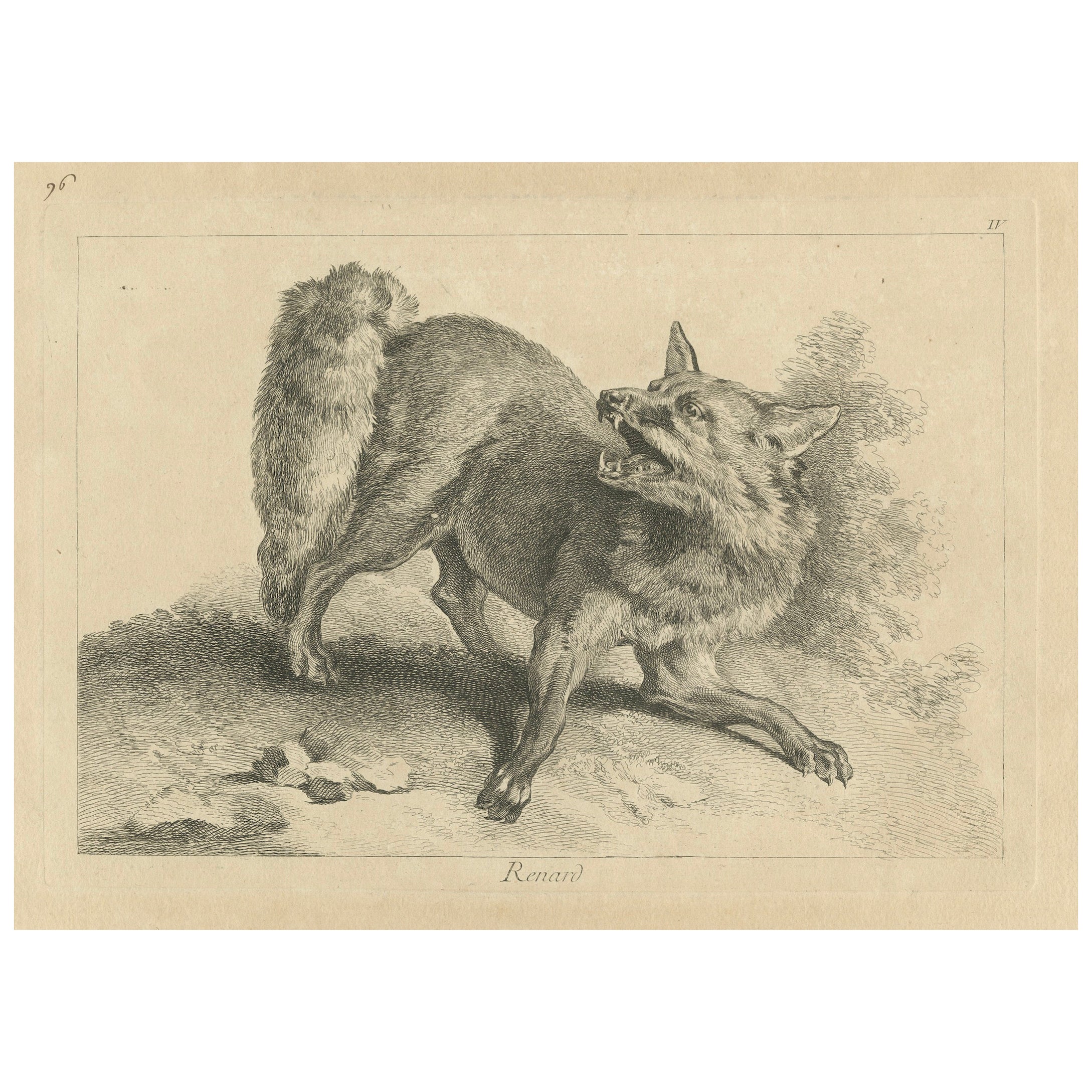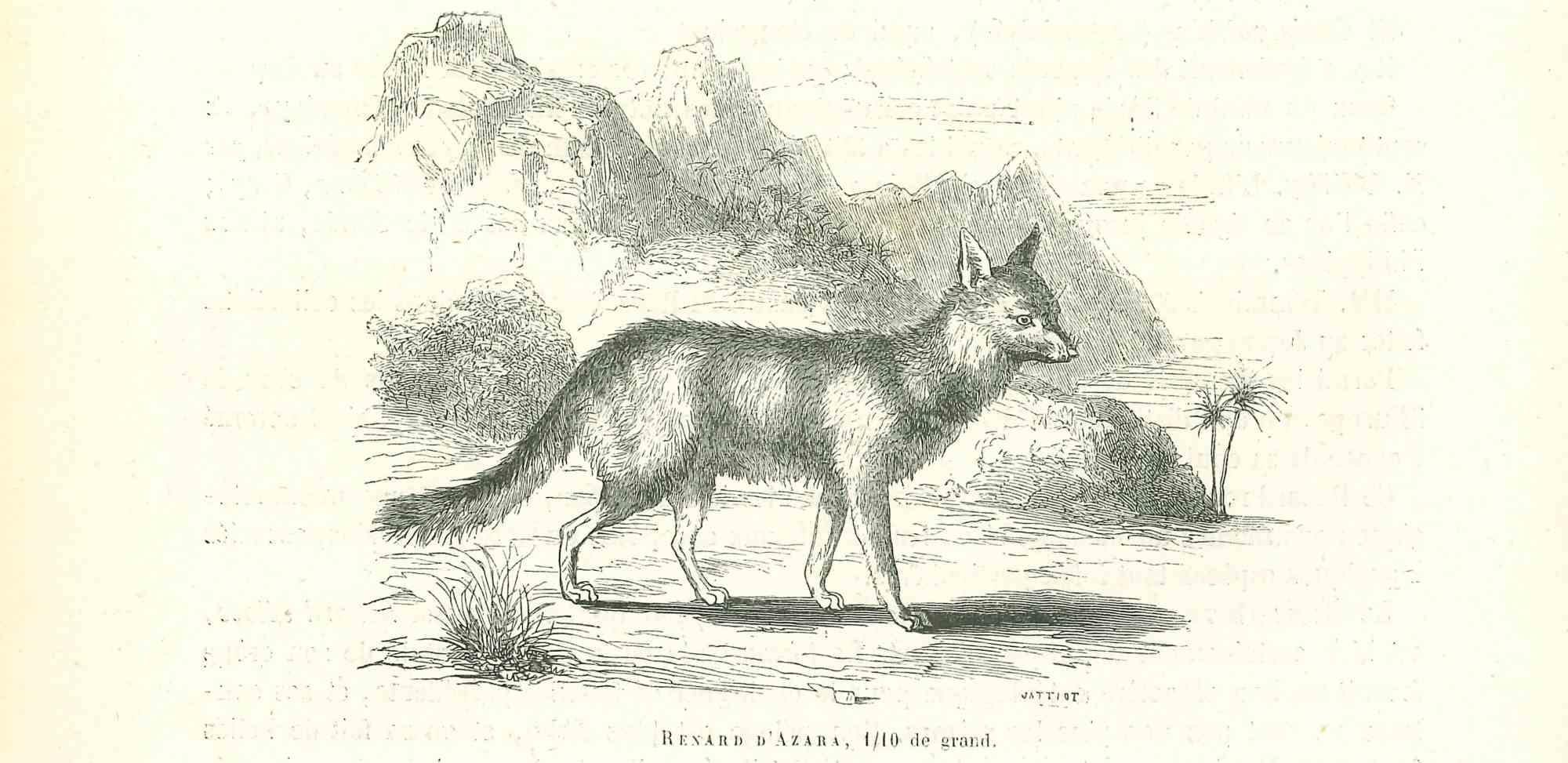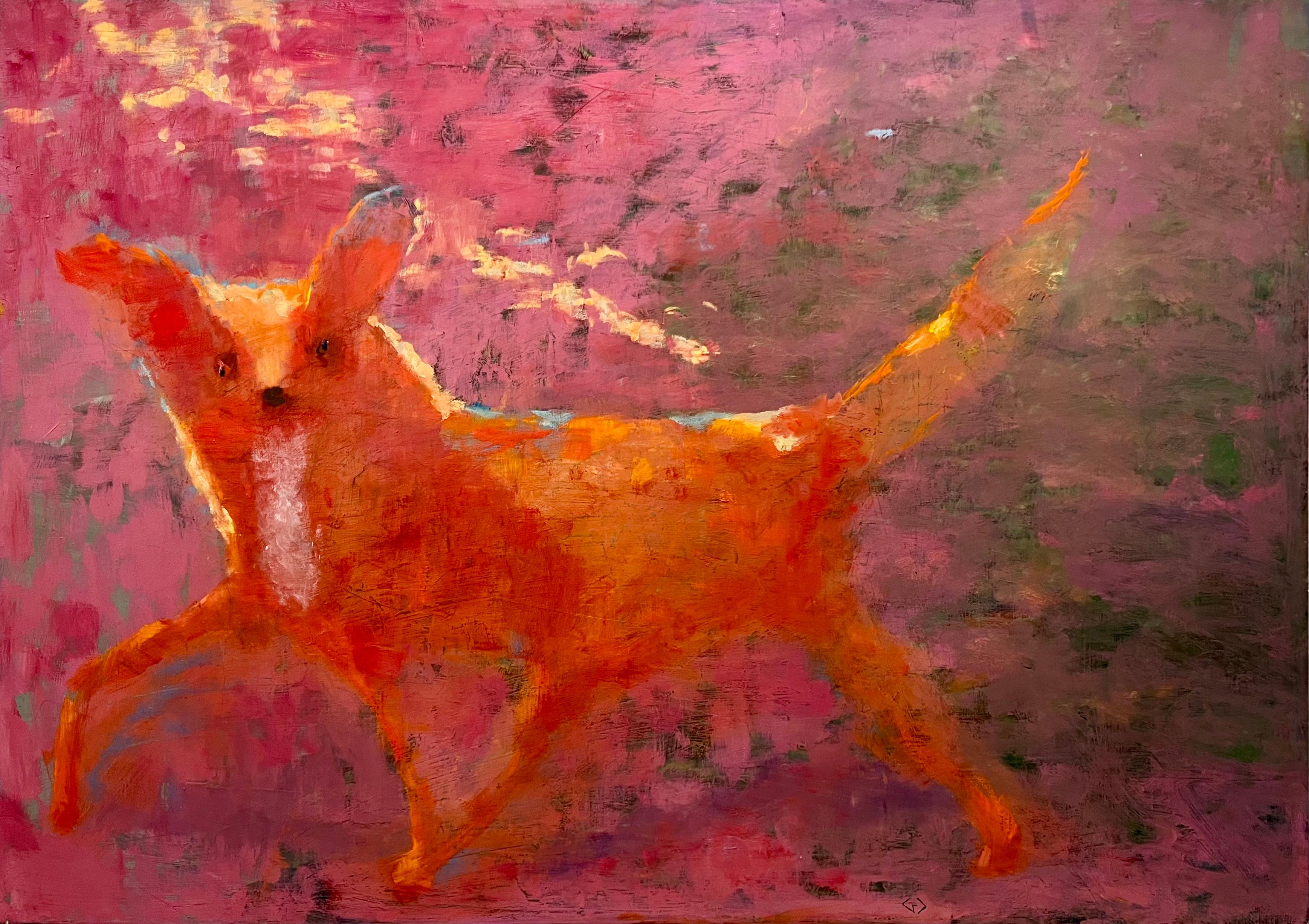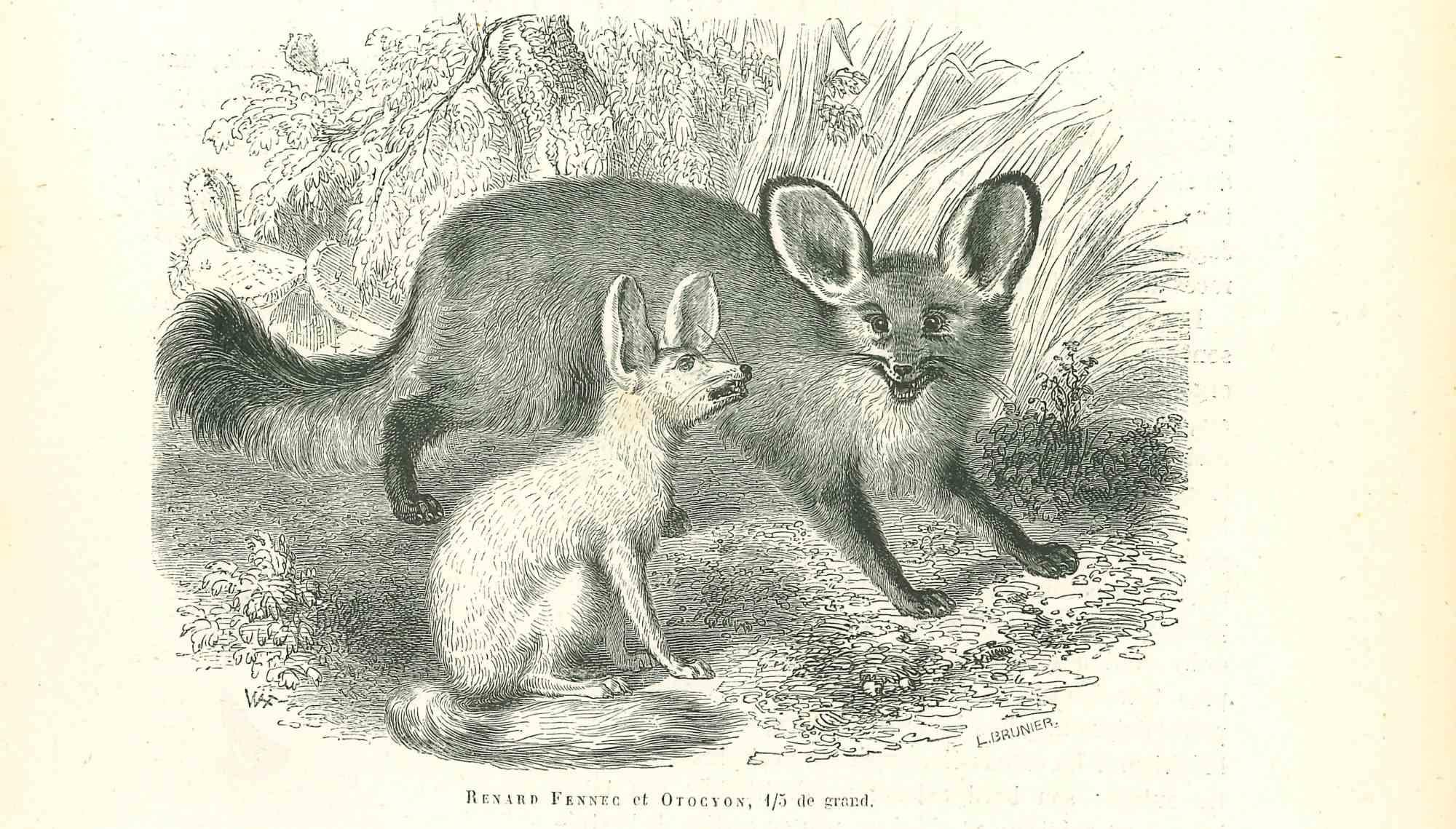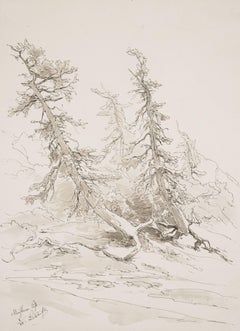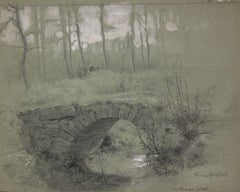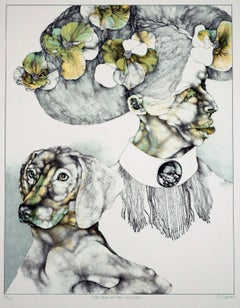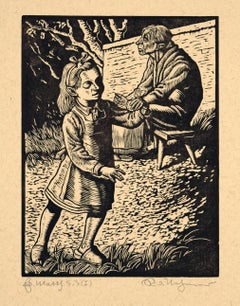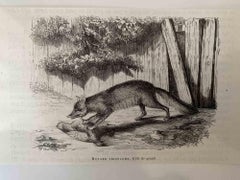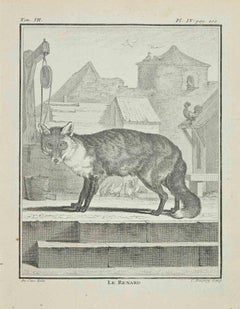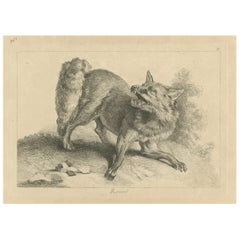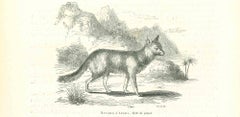Items Similar to Vigilant Fox - The psyche of the fox -
Video Loading
Want more images or videos?
Request additional images or videos from the seller
1 of 6
Carl Friedrich DeikerVigilant Fox - The psyche of the fox -1854
1854
$1,336.06
$1,670.0820% Off
£987.77
£1,234.7120% Off
€1,120
€1,40020% Off
CA$1,837.73
CA$2,297.1620% Off
A$2,042.75
A$2,553.4420% Off
CHF 1,070.77
CHF 1,338.4620% Off
MX$24,946.95
MX$31,183.6920% Off
NOK 13,367.91
NOK 16,709.8920% Off
SEK 12,576.71
SEK 15,720.8920% Off
DKK 8,526.54
DKK 10,658.1820% Off
About the Item
Carl Friedrich Deiker (1838 Wetzlar - 1892 Düsseldorf). Vigilant fox. Pencil drawing on brown paper, 18 × 29.5 cm (inside measurement), 31.5 x 43.5 cm (mount), signed and dated "Deiker [18]54" at lower right.
- a little bit stained, with a light water stain at lower right
About the artwork
Carl Friedrich Deiker's consummate ability to depict animals is already evident in this early work. He brought a whole new psychological dimension to animal painting, so that one could literally speak of animal portraits.
The naturalistic appearance of the fox alone makes it seem alive. Every strand of muscle, even every hair, is captured, which requires an intensive artistic study of animal anatomy and physiology. But the fox's real liveliness comes not from its natural appearance, but from its internal movement: Stretched out, it has been brought out of rest. It turns around and, with its ears pricked up, looks intently in the direction from which it has seen something. His mouth is slightly open and his pointed teeth are bared, as if he were growling. Tension gradually takes hold of his whole body. While the hind legs were still in a relaxed position, closely observed by Deiker, one front leg was already raised, ready to begin a rising movement. The fox seems so alarmed with all its senses that one gets the impression that, at any moment, its tail will move jerkily and the animal will jump up.
While wild animals have traditionally been portrayed as beasts or anthropomorphised, often for caricatural purposes, Deiker explores their inherent nature by attempting to capture their psychic impulses. The wild animal is neither bestial nor human, but a creature in its own right, valued by Deiker for its own sake. In this way, he brought the dignity of the animal into representation and raised animal painting to a whole new artistic level.
About the artist
Carl Friedrich Deiker was the son of the drawing teacher Christian Friedrich Deiker and the younger brother of the animal painter Johannes Deiker. In addition to the family art lessons, Christian Friedrich shared a studio with his brother Johannes at Braunfels Castle, Deiker attended the drawing academy in Hanau, and from 1858 he was a student at the Karlsruhe Art Academy, where he studied under the landscape painter Johann Wilhelm Schirmer. Carl Friedrich Deiker was already in demand as an artist during his first year: Grand Duke Frederick I of Baden, Margrave Max of Baden and Grand Duke Michael of Russia bought hunting scenes by him.
In 1859 he went on a study trip to the Reinhardswald. Just as the Barbizon School had rediscovered the landscape, Deiker opened up the forest for animal painting.
From 1861-64 Deiker had his own studio in Karlsruhe, then moved to Düsseldorf, where his brother Johannes followed four years later. Deiker married a daughter of the landscape painter Karl Hilger and remained in Düsseldorf until his death.
In 1868 he finally achieved international fame with his painting 'Pursued Noble Deer' and was regarded as a virtuoso new founder of animal painting.
"Deiker brought for the first time a truly great artistic quality to animal painting [...]".
- Hans Vollmer
From 1870 he participated in the academic art exhibitions in Berlin, Dresden, Munich and Hanover. He was also very busy as an illustrator. He drew for the Gartenlaube, the Salon, the Universum, and produced many of the finely illustrated hunting and animal books of the period. He also worked as a printmaker, while his oil paintings circulated as reprints by Franz Dinger.
From 1865 to 1892 Deiker was a member of the artists' association Malkasten.
Carl Friedrich Deiker's life's work was honoured with a large posthumous memorial exhibition at the Düsseldorf Kunsthalle in 1892.
His son Carl Deiker, born in 1879, also became a painter.
Selection of art museums that own works by Carl Friedrich Deiker:
Hamburger Kunsthalle / Kunsthalle Karlsruhe / Kunstmuseum Düsseldorf / Wallraff Richartz Cologne.
Selected Bibliography
H. Schmidt: Johannes and Carl Friedrich Deiker. A contribution to animal and hunting painting in the 19th century, Wetzlar 1986.
Thank you for your interest! I hope I have been able to explain to you the special character of the artwork. If you have any questions of any kind, please feel free to contact me.
I wish you many more discoveries in the realm of art,
Dr Martin Kirves
GERMAN VERSION
Carl Friedrich Deiker (1838 Wetzlar - 1892 Düsseldorf). Wachsamer Fuchs. Bleistiftzeichnung auf braunem Papier, 18 × 29,5 cm (Innenmaß), 31,5 x 43,5 (Passepartout), rechts unten signiert und datiert „Deiker [18]54“.
- etwas stockfleckig, rechts unten mit leichtem Wasserrand
zum Werk
Bereits bei diesem frühen Werk Carl Friedrich Deikers zeigt sich die vollendete Fähigkeit des Künstlers, Tiere darzustellen. Er bringt eine ganz neue psychologische Dimension in die Tiermalerei ein, so dass regelrecht von Tierporträts gesprochen werden kann.
Schon aufgrund seiner naturalistischen Erscheinung wirkt der Fuchs wie lebendig. Jeder Muskelstrang, ja jedes einzelne Härchen ist ‚haargenau‘ getroffen, was ein intensives künstlerisches Studium der Tieranatomie und -physiologie voraussetzt. Seine eigentliche Lebendigkeit gewinnt der Fuchs aber nicht durch seine naturgemäße Erscheinung, sondern durch seine innere Regung: Ausgestreckt hingelagert, wurde er aus der Ruhe gebracht. Er wendet sich um und blickt mit gespitzten Ohren gespannt in die Richtung, aus welcher er etwas gewahrt hat. Dabei ist sein Maul leicht geöffnet und die spitzen Zähne entblößt als ob er knurren würde. Die Anspannung nimmt allmählich von seinem ganzen Körper Besitz. Während die Hinterläufe noch in einer von Deiker genau beobachteten entspannten Haltung liegen, ist der eine Vorderlauf bereits aufgerichtet, bereit eine Aufstehbewegung zu initiieren. Der Fuchs wirkt mit allen seinen Sinnen derart alarmiert, dass sich der Eindruck einstellt, sein Schwanz würde sich im nächsten Augenblick ruckartig bewegen und das Tier aufspringen.
Waren Wildtiere zuvor vor allem als Bestien dargestellt oder – oftmals zu karikierenden Zwecken – anthropomorphisiert worden, erkundet Deiker das ihnen eigene Wesen, indem er die psychischen Regungen der Tiere zu erfassen sucht. Das Wildtier ist weder bestialisch noch menschlich, sondern ein ganz eigenes Geschöpf, das von Deiker um seiner selbst willen gewürdigt wird. Damit bringt er die Würde des Tieres zur Darstellung und hebt die Tiermalerei auf ein ganz neues künstlerisches Niveau.
zum Künstler
Carl Friedrich Deiker war Sohn des Zeichenlehrers Christian Friedrich Deiker und der jüngere Bruder des Tiermalers Johannes Deiker. Neben dem familiären künstlerischen Unterricht, Christian Friedrich teilte sich zusammen mit seinem Bruder Johannes ein Atelier im Schloss Braunfels, besuchte Deiker die Zeichenakademie in Hanau und war ab 1858 Student der Kunstakademie Karlsruhe, wo er bei dem Landschaftsmaler Johann Wilhelm Schirmer lernte. Bereits im ersten Studienjahr war Carl Friedrich Deiker ein gefragter Künstler: Der Großherzog Friedrich I. von Baden, der Markgraf Max von Baden und Großfürst Michael von Russland erwarben Jagdstücke aus seiner Hand.
1859 erfolgte eine Studienreise in den Reinhardswald. So wie die Schule von Barbizon die Landschaft für die Landschaftsmalerei neu entdeckte, erschloss Deiker den Wald für die Tiermalerei.
Von 1861-64 führte Deiker ein eigenes Atelier in Karlsruhe, um dann nach Düsseldorf überzusiedeln, wohin ihm sein Bruder Johannes vier Jahre später nachfolgte. Deiker ehelichte eine Tochter des Landschaftsmalers Karl Hilger und verblieb bis zu seinem Tod in Düsseldorf. Mit dem Bild „Verfolgter Edelhirsch“ gelangte er 1868 endgültig zu internationalem Renommee und galt als virtuoser Neubegründer der Tiermalerei.
„Deiker brachte zuerst einen wirklich großen künstlerischen Zug in die Tiermalerei […].“
- Hans Vollmer
Ab 1870 beschickte er die akademische Kunstausstellungen in Berlin, Dresden, München und Hannover. Zudem war er eifrig als Illustrator tätig. Er zeichnete für die Gartenlaube, den Salon, das Universum und fertigte zahlreiche Vorlagen für die damals hochwertig illustrierten Jagd- und Tierbücher an. Auch war er selbst als Druckgrafiker tätig, während seine Ölbilder als Nachstiche von Franz Dinger kursierten.
Von 1865 bis 1892 war Deiker Mitglied in der Künstlervereinigung Malkasten.
Mit einer großen posthumen Gedächtnisausstellung in der Düsseldorfer Kunsthalle wurde 1892 das Lebenswerk Carl Friedrich Deikers gewürdigt.
Sein 1879 geborener Sohn, Carl Deiker, wurde ebenfalls Maler.
Auswahl an Kunstmuseen, die Werke von Carl Friedrich Deiker besitzen:
Hamburger Kunsthalle / Kunsthalle Karlsruhe / Kunstmuseum Düsseldorf / Wallraff Richartz Köln
Auswahlbibliographie
H. Schmidt: Johannes und Carl Friedrich Deiker. Ein Beitrag zur Tier- und Jagdmalerei im 19. Jahrhundert, Wetzlar 1986.
Vielen Dank für Ihr Interesse! Ich hoffe, ich habe Ihnen den besonderen Charakter des Kunstwerks näherbringen können. Bei Fragen jeglicher Art können Sie mich gerne kontaktieren.
Ich wünsche Ihnen noch viele Entdeckungen im Reich der Kunst,
Dr. Martin Kirves
- Creator:Carl Friedrich Deiker (German)
- Creation Year:1854
- Dimensions:Height: 7.09 in (18 cm)Width: 11.62 in (29.5 cm)
- Medium:
- Movement & Style:
- Period:
- Condition:
- Gallery Location:Berlin, DE
- Reference Number:1stDibs: LU2438212304312

About the Seller
5.0
Vetted Professional Seller
Every seller passes strict standards for authenticity and reliability
Established in 2014
1stDibs seller since 2023
21 sales on 1stDibs
- ShippingRetrieving quote...Shipping from: Berlin, Germany
- Return Policy
Authenticity Guarantee
In the unlikely event there’s an issue with an item’s authenticity, contact us within 1 year for a full refund. DetailsMoney-Back Guarantee
If your item is not as described, is damaged in transit, or does not arrive, contact us within 7 days for a full refund. Details24-Hour Cancellation
You have a 24-hour grace period in which to reconsider your purchase, with no questions asked.Vetted Professional Sellers
Our world-class sellers must adhere to strict standards for service and quality, maintaining the integrity of our listings.Price-Match Guarantee
If you find that a seller listed the same item for a lower price elsewhere, we’ll match it.Trusted Global Delivery
Our best-in-class carrier network provides specialized shipping options worldwide, including custom delivery.More From This Seller
View AllWoodland / - The Inner Drama of the Landscape -
Located in Berlin, DE
Eduard Peithner von Lichtenfels (1833 Vienna - 1913 Berlin), Woodland, 1884. Watercolor and pen and ink on drawing paper, 30.4 cm x 22.5 cm, signed, dated and inscribed by the artist...
Category
1880s Landscape Drawings and Watercolors
Materials
Paper
In the forest of Durlach - Quiet ripple in a secret place -
Located in Berlin, DE
Franz Xaver Graessel (1861 Oberasbach/Baden - 1948 Emmering). In the forest of Durlach. 1881. Pencil drawing, heightened with white, on grey-green paper. 33 x 41.7 cm. Signed, dated and inscribed by the artist himself: 'Franz Graessel. Durlach, 12 April 1881".
About the artwork
The drawing depicts a view of the woods which, as if sharpening the visual focus, remains diffuse at the edges and does not allow the viewer to locate himself in the picture. As a result, the landscape appears to be an apparition, but at the same time it is given real substance by the solidity of the massive arched bridge made of quarry stone. As the main motif of the painting, the bridge, which blends in with nature like an archaic relic, also acts as a visual guide, drawing attention to the white, raised waters of the stream and the surrounding vegetation. The diffusion of perception that takes place there, however, draws the eye back to the bridge and thus to the overall view. This movement initiating a constant alternation of diffusion and concretion, which is the specific tension of the painting that brings the landscape to life. The materialisation and dematerialisation, however, does not take place solely through the eye's wandering through the picture; it is simultaneously linked to the viewer's approach to and distance from the picture, which loses its richness of detail precisely in the close-up, only to reconfigure itself with increasing distance.
In this work, which dates from Graessel's studies in Karlsruhe, the artist reflects on the emergence of pictorial objectivity. Here, however, nature is more than a mere motif. The real connection between culture and nature is symbolically expressed by the choice of green paper.
The drawing is an impressive testimony to Graessel's mastery of the sprezzatura with which he skilfully applies the most abstract of strokes, which visibly merge towards the centre of the picture. The signature and the exact date prove that Graessel gave this work more than the character of a mere sketch.
About the artist
Franz Graessel grew up in an environment that was to nourish his later key motifs: his parents' house was a mill. After attending the Karlsruhe Academy of Art from 1878 to 1884, where he studied under Carl Hoff, Graessel continued his training at the Munich Academy from 1886 to 1890 as a pupil of Wilhelm von Lindenschmidt. Trained primarily in genre and portrait painting, he initially portrayed the life of Black Forest farmers. From 1894 he turned increasingly to animal painting, concentrating on the depiction of ducks and geese, which earned him the nickname 'Enten-Graessel'. Graessel's work thus parallels that of Alexander Koester...
Category
1880s Naturalistic Landscape Drawings and Watercolors
Materials
Chalk, Pencil, Paper
$2,290 Sale Price
20% Off
The Lady with the Dog / - Like the master, so the dog -
By Reiner Schwarz
Located in Berlin, DE
Reiner Schwarz (*1940 Hirschberg), The Lady with the Dog, 1971. Lithograph, 33 cm x 26 (image), 59 cm x 42 cm (sheet size), signed in pencil at lower right "R.[ein] Schwarz", dated "...
Category
1960s Surrealist Figurative Prints
Materials
Paper
Blessed are the spiritually poor / - The Abundance of Poverty -
Located in Berlin, DE
Rudolf Nehmer (1912 Bobersberg - 1983 Dresden), Blessed are the spiritually poor, 1948. Woodcut on yellowish wove paper, 20 cm x 15 cm (image), 45 cm x 30 cm (sheet size), signed “Ru...
Category
1940s Realist Figurative Prints
Materials
Woodcut
The actor Karl Seydelmann, probably as Max Piccolomini / - Theatrical Realism -
Located in Berlin, DE
Theodor Hosemann (1807 Brandenburg - 1875 Berlin), The actor Karl Seydelmann probably as Max Piccolomini, around 1840. Watercolor with pencil, 20.5 cm (height) x 14.7 cm (width), sig...
Category
1840s Realist Figurative Drawings and Watercolors
Materials
Paper
Rebekka / - Rebekka's Appearance -
Located in Berlin, DE
Emil Wachter (1921 Neuburgweiser - 2012 Karlsruhe), Rebekka, 1987. Watercolor mounted on cardboard, 13.5 (height) x 14 cm (width). Signed “E.[mil] Wa[chter]” in pencil within the ima...
Category
1980s Realist Figurative Drawings and Watercolors
Materials
Paper
You May Also Like
The Hunting Fox - Lithograph by Paul Gervais - 1854
By Paul Gervais
Located in Roma, IT
The Hunting Fox is an original lithograph on ivory-colored paper, realized by Paul Gervais (1816-1879). The artwork is from The Series of "Les Trois Règn...
Category
1850s Modern Animal Prints
Materials
Lithograph, Paper
Le Renard - Etching by Jean Charles Baquoy - 1771
Located in Roma, IT
Le Renard is an etching realized by Jean Charles Baquoy in 1771.
It belongs to the suite "Histoire Naturelle de Buffon".
The Artist's signature is engraved lower right.
Good condi...
Category
1770s Modern Figurative Prints
Materials
Etching
Renard, The Red Fox: An Original Detailed Etching - circa 1740
Located in Langweer, NL
This etching and engraving, titled "Renard," depicts a fox in a dynamic and alert posture. The artwork captures the fox's thick fur, bushy tail, and sharp features with exquisite det...
Category
Antique 1740s Prints
Materials
Paper
$417 Sale Price
20% Off
The Wolf - Original Lithograph by Paul Gervais - 1854
By Paul Gervais
Located in Roma, IT
The Wolf is an original lithograph on ivory-colored paper, realized by Paul Gervais (1816-1879). The artwork is from The Series of "Les Trois Règnes de la Nature", and was published ...
Category
1850s Modern Animal Prints
Materials
Lithograph, Paper
Fox II
By Greg Decker
Located in Atlanta, GA
Greg's witty and charming oil painting on aluminum comes framed in a floater frame which adds 1.75 inches all the way around. "Greg Decker is a visionary painter. His work epitomize...
Category
2010s Contemporary Animal Paintings
Materials
Metal
$5,200
Renard Fennec - Original Lithograph by Paul Gervais - 1854
By Paul Gervais
Located in Roma, IT
Renard Fennec is an original lithograph on ivory-colored paper, realized by Paul Gervais (1816-1879). The artwork is from The Series of "Les Trois Règnes de la Nature", and was publi...
Category
1850s Modern Figurative Prints
Materials
Lithograph
More Ways To Browse
Fox Hunting
Pencil Leg
Dior So Real
Antique Fox Hunting
Fox Hat
Fox Hunting Painting
Schmidt Oil Painting
Antique Deer Painting
Deer Legs
Dior Fur Hat
Large Hunting Landscape Oil Paintings
19th Century Male Oil Paintings
Antique Fox Hunting Paintings
Antique Hunting Books
Fox Hunting Oil Painting
Hamburger Painting
Carl Wilhelms
Hans Schmidt Art
